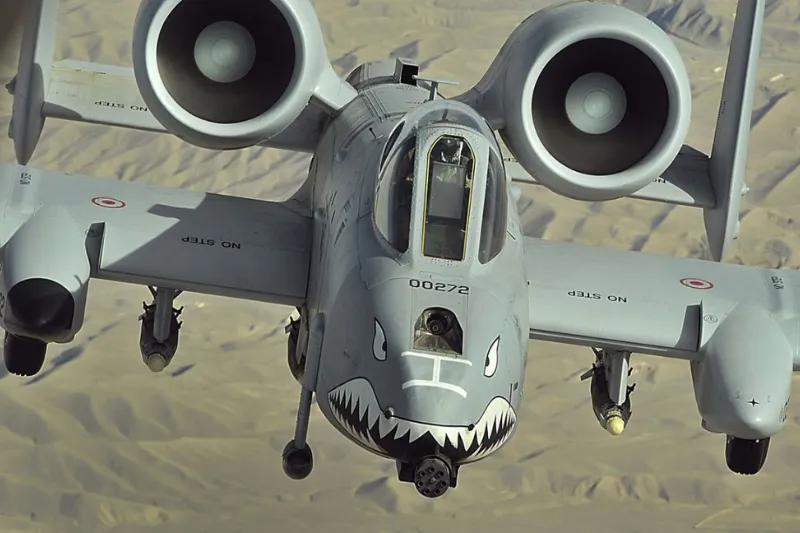2-SECOND BURSTS
SHORT THOUGHTS ON LEADERSHIP, DECISION-MAKING, FLIGHT, AND OTHER TOPICS OF THE DAY
ARTICLES

Rebutting The Reasons To Hate The A-10 Or The Next A-X
As I previously shared, there are many reasons why many AirPower advocates hate the A-10. In general, they are not idiots, have well-thought out reasoning to disparage the airframe and wish the Air Force had been able to remove all resources from its program years ago. These Airpower advocates and the their supporters in industry are red-blooded Americans who take our National Security seriously. For the most part, however, they are simply wrong on CAS. And what is missing from the entire argument is the mystery of why the Air Force has not developed a CAS replacement airframe. Let me highlight a few points by first focusing on the reasons why so many don't like the A-10:
The Mission. CAS will always be front and center to the joint fight. The CAS force is not the "Kick down the door' team of F-22s/B-2s/B-21s/F-35s/NGAD/CCAs and even the F-15C/E/EXs, but as it has historically borne out, it is the Day 7+ team that grinds out the event-driven fight that leads to final victory. While all Airpower tasks are Joint, the day-to-day CAS fight creates some of the most joint-minded Airmen. TACP/STS Airmen live with the Army/SOF, train with all services that either need air or provide air, and understand everything down to the Army's focus on the battlefield, way of issuing orders, organization, etc. CAS aircrew study the ground scheme of maneuver, coordinate with the ground forces, and claw for information to understand the Ground Commanders' intent while seeing the ants move below among the mud and trees and lego stick houses. Like Air-to-Air, CAS skills are not those of a hobbyist, and they translate to the support of Surface Warfare, civilian movement, airfield protection, and a whole slew of other situations where the crews' skills application demands detailed integration during execution, not just in the planning stages.
Speed. Yes, the A-10 is slow. For much of the CAS fight, that makes it a much better platform to see, process, and position the aircraft where it needs to be. For employment in the CAS arena, the A-10 flight envelope is actually perfect--slow enough to absorb the battlefield, fast enough to be in on a target quicker than the pilot can process what needs to happen and get direction from the Joint Terminal Attack Controller/Ground Commander. Where it lacks speed is for the enroute portion of the mission. This can be easily fixed for pennies on the dollar with a COTS hot section replacement, or for a more robust solution you can replace the fuel control with a digital one and the fan blades with variable blades (TF-34-100B). The entire cost of that would be less for the whole fleet than just the development of a 2nd engine for the F-35, never mind the procurement of that 2nd engine. Ingress and egress speeds with the minor upgrades would reduce the burden placed on the rest of a force package, allowing the A-10 to blend in much better and reduce overall time on station for the force package.
Range. I've flown over 1,000 nautical miles on internal fuel alone in the A-10 with plenty of reserves. That is not eye-watering, but more than sufficient for any theater except for INDOPACOM. A single external tank solves that problem, or the previously-stated engine mod by providing greater lb/mile efficiency at all altitudes, or greater thrust to fly at higher fuel-sipping altitudes. Again, pennies on the dollar.
Thrust. I've taken off on a high density altitude day where--without perfect response--my only option was to eject in the case of an engine failure. Again, for pennies on the dollar an engine upgrade--something every fighter except for the F-22 and so far the F-35--have received--would fix this. The additional thrust would increase the climb capability and the energy in reserve significantly enough to allow for operation above most threats in a CAS environment, greater climb away from threats, lower energy bleed rates, and great energy on weapons to create greater standoff, and greater dash speeds (OK I know all faster fighter pilots will mock the use of the word dash and A-10 in the same breath).
Sensors and weapons suite. The existing mission computer suite on the A-10, while hampered by memory issues, still is able to integrate advanced targeting pods, podded radars, and a helmet-mounted cueing system that cost less than the lunch money for the JHMCS engineering team, with room to grow. An integrated radar would be nice for many tactical situations, but not essential for most. The weapons solutions on the A-10 are second to none in terms of flexibility and accuracy for a wide range of weapons that continues to grow.
Radar Cross Section is terrible, but RCS is only one component of stealth. Above 5,000 feet, an A-10 is virtually silent to ground forces compared to any other fighter, especially the newer 5th gen beasts. I love the sound of a fighter at full throttle, but the enemy is able to find and cue off those same sounds. Ask a special operator team if they want 5th gen fighters anywhere near their objective when surprise is a factor, and they will tell you 'no'. Let them be a bomb donor from a long distance, but nowhere near the actual fight.
Overall low-tech. I've always said, "spend as much as it takes, not a penny more." The same is true with tech and the associated costs that come with tech. I love my nail gun. But when I'm performing certain tasks, I don't touch the compressor. I grab my claw hammer. At the same time, the A-10 has tech where it counts. Sensors, coordinate-generation computing, redundant systems, reliability, and more all provide the tech needed for most every CAS mission.
It's looks. Defense is not a beauty contest. It is the application of force. Nothing says I hate you more than 11 weapons stations and a 7-barrel Gatlin Gun.
Single-mission focus. There are many jobs that require a near singular focus for training, education, and execution. CAS, especially CAS in a complex environment, is one of those missions. I'm not going to let my primary care doctor perform heart surgery because he did a cardiovascular rotation as a resident. I want a specialist. I'm pretty sure the parents of that 18-year-old with a rifle would feel the same about CAS. So many platforms and crews from other weapons systems have performed CAS admirably because the crews embraced the mission and were virtually stripped of their other tastings in preparation for their CAS deployment. Yet even with that focus, nearly none of those crews can perform a strafing run 30 meters away from friendly forces in the middle of a heated firefight on the ground. And for the record, the A-10 is more than a one-trick pony (CSAR, FAC-A, situational SEAD/DEAD, etc).
Some additional considerations that make the A-10 so valuable are:
Payload. The A-10s payload is not the largest, but surely the most diverse. During Operation INHERENT RESOLVE, A-10s regularly carried 1XGBU-31, 2x GBU-54s, 2x AGM-65, 1x GBU-38, 7x AGR-20s, and 1150 rounds of 30mm. That's two stationary targets, and 18 moving targets on a single aircraft. Currently, there are options to carry up to 16 Miniature Air-Launch Decoys, and 16 Small Diameter Bombs on just four weapons stations.
Loiter time. CAS is about 'being there'. An A-10 on station can loiter for up to 2 hours. Yes, they'll have to employ tactics and be smart to avoid threats when over/near the battle space for an extended period of time. That is what training is for. Also what the over 480+ anti-infrared or anti-radar expendables are for. And the Electronic Countermeasures Pod. And the Missile Warning System. And the advantage of working in a joint force where players have each others' backs.
Austere employment. No other fighter airframe can operate from small, austere airfields, period. The logistical tail required for an A-10 vice an F-35 or F-16 is a small fraction, and that same F-16 cannot operate off of a dirty, pock-marked airfield. The A-10 can with zero issues except a dirty canopy.
Small fuel footprint. Relative to any other fighter/bomber, the A-10 sips gas. Where tankers are the long pole in the tent in just about every theater, I am amazed that the Air Force has not developed larger tankers or focused even some of its development efforts on reducing the fuel requirements of the Combat Air Forces. The fuel required to push Fat Amy above the mach is crazy.
Total Ownership Cost. The main cost drivers for the A-10 are due to neglect. The central computer has a high failure rate, and the Air Force spends 100's of millions of dollars just putting a bandaid on that. each year Structurally, the Air Force finally purchased new wings to extend the airframe's longevity, but the acquisition gross negligence to get there cost artificially drove up sustainment costs on the airframe. But even with those large cost drivers, the A-10 pales in comparison to every other fighter. It is simple mass and economy rolled into one. The Air Force tried to tell the story that it was too expensive years ago, but that was flatly dishonest.
Pilot absorption. Reference #5 above, the Air Force struggles mightily to create and season enough fighter aircrew. If we go to an all-5th gen fleet, it will bankrupt the force and fail to produce anywhere near the number of air-minded crew it needs. We don't need joystick nerds. We need warriors who have placed their pink bodies at risk three dimensionally in the name of freedom.
Contested Operations. Year over year, during large force exercises at Nellis, the A-10s are a part of the force that 'get through the monster IADs to crush the unbeatable threats with a face shot from 1 mile at 100 feet.
The A-10 needs to retire sooner rather than later. But nothing in the pipeline covers the CAS mission as is needed. We can talk all day about "Contested Ops", and that has to be part of the calculus. But that is only a portion of the fight the Air Force will be asked to perform. And probably a small portion. In fact, the success of the deterrence may drive us exactly into other fights that limit where/how we apply AirPower. And we'll wish we had a small Air Force of cheap attack aircraft manned by CAS experts to handle the mess.

CONTACT DEREK!

MEDIA INQUIRIES
Members of the press are welcome to contact us regarding any requests at [email protected] ;
(385) 777-6285

